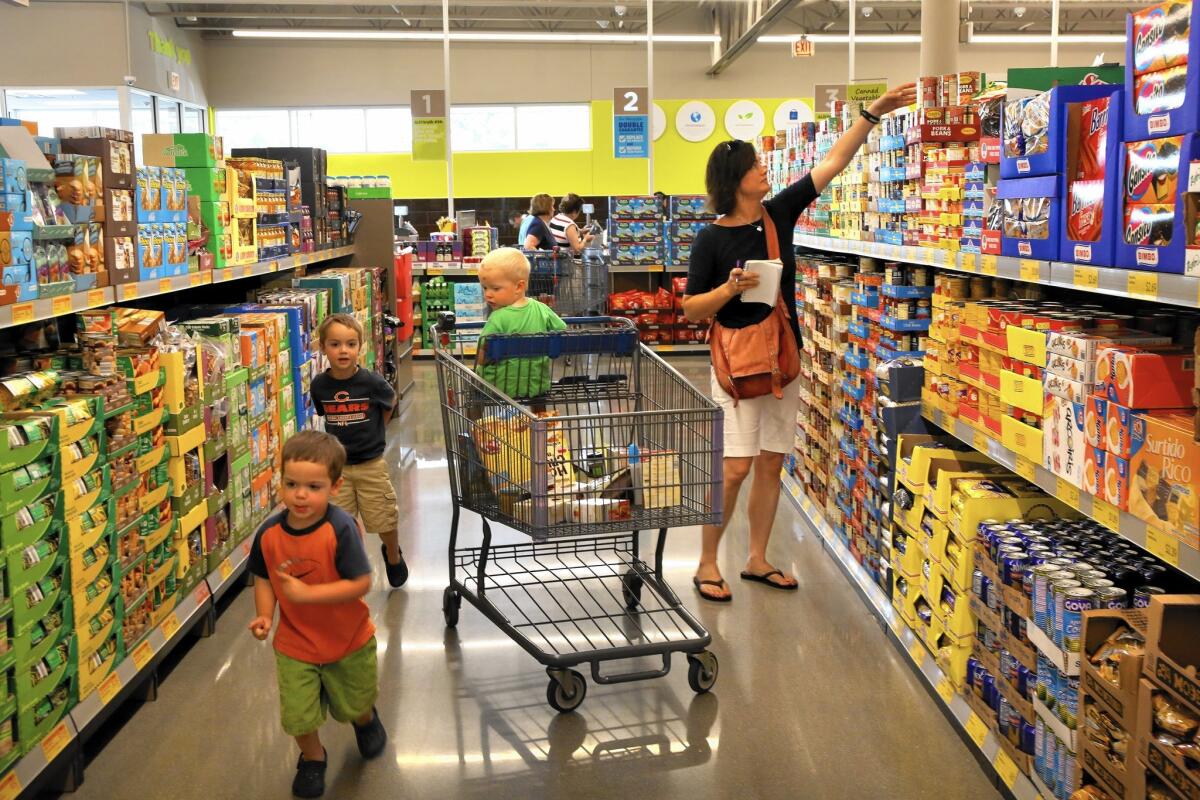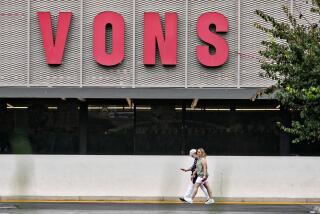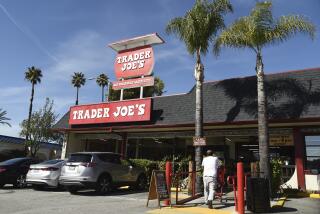Discount grocer Aldi to open 45 stores in Southland

Aldi, which has 1,400 stores in 32 states, landed in the U.S. in 1976 and has grown steadily for decades. Above, shoppers at an Aldi store in Niles, Ill.
German discount grocer Aldi plans to open the first of 45 Southern California stores in March, a move that analysts say could force some competitors to lower prices.
That’s just the start for Aldi, which has quietly expanded to nearly 1,400 locations in 32 states over the last few decades. The company is building a regional headquarters and distribution center in Moreno Valley to support further expansion in coming years, said Jason Hart, Aldi’s chief executive for U.S. operations.
“There is no other place with the same density of people that exists in Southern California,” Hart said in an interview. “It’s an important market with really big potential for us.”
Aldi is coming to a region with a growing bounty of food options.
Haggen, a Pacific Northwest chain, is in the process of rebranding 83 supermarkets that it bought in the Golden State. Retail giants Wal-Mart Stores Inc. and Target Corp. are briskly expanding their grocery options. Online players Google and Amazon.com are jumping into grocery delivery.
The addition of Aldi will tighten the squeeze on Southland supermarkets, which have been scrambling to offer customers more options both online and at stores. Safeway and Albertsons merged earlier this year to try to gain an edge. Now, Aldi’s entrance will force grocers to compete fiercely for patronage, some analysts said.
Aldi has “long-term potential for changing the market” in Southern California, said food analyst Jim Prevor, founder of PerishablePundit.com. “But it’s going to take them a long time before they have a critical mass of stores that they can shift the whole market.”
Some new contenders such as Fresh & Easy have struggled to differentiate themselves in a crowded field. But industry experts say Aldi has a clear concept to sell to shoppers: Good quality at deep discounts.
“Fresh & Easy and Aldi stores are roughly the same size,” said Jim Hertel, managing director of food retail consulting firm Willard Bishop. “The difference is with Aldi, you walk in there expecting to pay less — significantly less.”
Aldi’s entrance will spark “a pronounced price war” in the region, said Burt Flickinger III, managing director of consulting firm Strategic Resource Group. “Aldi has been Wal-Mart’s worst nightmare. It will be tough on Costco as well as all the established food retailers.”
By attracting Southern California families tired of rising food prices, the discount chain could open up to 100 stores within a decade and 250 stores in the next 20 years, he said.
“Aldi has always done best with markets with the highest cost of living,” Flickinger said. “California has the highest cost of living in the continental United States.”
But making a profit in the Southland can be tricky for supermarkets.
The region is “by far the biggest food market in the U.S. and Canada,” Flickinger said. “The issue is that the cost of real estate and taxes and other operating costs are so high. Retailers typically make less money in California even though prices are higher.”
Fresh & Easy is a cautionary tale.
British supermarket giant Tesco lost about $2 billion on the chain, which was launched eight years ago. Crowds of shoppers were eager to try the new stores in 2007, but eventually many were turned off by the unknown products and paltry service.
In 2013, billionaire Ron Burkle’s Yucaipa Cos. bought Fresh & Easy and began closing poorly performing stores, introducing new products and developing new formats.
Aldi has a unique concept that stands out from stalwarts such as Ralph’s and Vons, analysts said. Aldi is controlled by the Albrecht family in Germany. (Through a family trust, the Albrechts also own Monrovia-based Trader Joe’s.)
The stores, which sport a spartan look, are more on par with drugstores at about 10,000 square feet, compared to a standard supermarket, which can clock in at 50,000 square feet or more.
More than 90% of the items for sale are Aldi’s private label. Each store carries about 1,300 items, offering only one or two options of peanut butter or canned green beans. That ensures hefty discounts from suppliers because Aldi buys in huge volumes. The reduced costs are passed to shoppers who can save 20% to 40% on most products, industry watchers say.
“It’s a big-time value play,” Hertel said. “You can probably do 85% to 90% of your weekly grocery shopping needs as long as you’re not brand conscious.”
Although the selection is small, Aldi also focuses on quality to lure shoppers who may shy away from private-label merchandise, analysts said.
“Supermarkets have cheap private label … but they intentionally make the package unattractive so as not to dissuade people from buying their higher-margin products,” food analyst Prevor said. “Aldi makes each item look good. Nobody feels stigmatized for having the ‘cheap’ product in their basket.”
The shopping experience also is a sharp departure from a typical grocery store.
Customers who want to use a shopping cart must deposit a quarter, which they get back once the cart is returned. The system prevents theft and also cuts down on workers needed to corral carts scattered in parking lots.
Shoppers must pack their own groceries.
Best-selling products are often put out on the floor on shipping palettes, instead of stacked on shelves.
That means each store needs only about 20 employees on average. That’s compared with large supermarkets with dozens or even a few hundred employees.
Aldi, which is non-union, will offer a starting wage of $13 an hour for California store employees. By the end of 2016, the chain will employ about 1,100 people in the state.
Aldi’s Hart acknowledges “there is a little bit of a learning curve” for first-time shoppers. The company is planning on “extensive” advertising to introduce the Aldi brand, which “needs to be explained a bit,” he said.
But customers quickly get used to Aldi, Hart said, once they see the prices.
“There’s an ‘aha’ moment, when they start to put together the way the store operates and the way we do things a little differently,” he said. “It really clicks that they are able to save significant amounts of money.”
So far, Aldi’s formula seems to be working.
The discount grocer landed in the U.S. in 1976 and grew steadily for decades. In 2014, the company began aggressively expanding, opening about 130 stores, a pace the company expects to continue until 2018.
Hertel said stores operated by the privately held company collectively muster annual sales increases in the high single digits for locations open at least a year. In comparison, Save-A-Lot reported a 3.6% rise and Kroger Co., parent of the Ralph’s chain, reported a 6% climb in same-store sales in the fourth quarter.
Hart said Aldi has increasingly attracted more affluent customers who enjoy a good bargain. Over the years, its store designs have been upgraded. In California, Aldi plans to carry a wider range of wines and organic produce than its stores in other states.
“The last 500 stores have really been in middle- and even upper-income areas,” Hart said. “They are higher-volume stores and experience faster growth.”
Twitter: @ByShanLi
More to Read
Inside the business of entertainment
The Wide Shot brings you news, analysis and insights on everything from streaming wars to production — and what it all means for the future.
You may occasionally receive promotional content from the Los Angeles Times.











